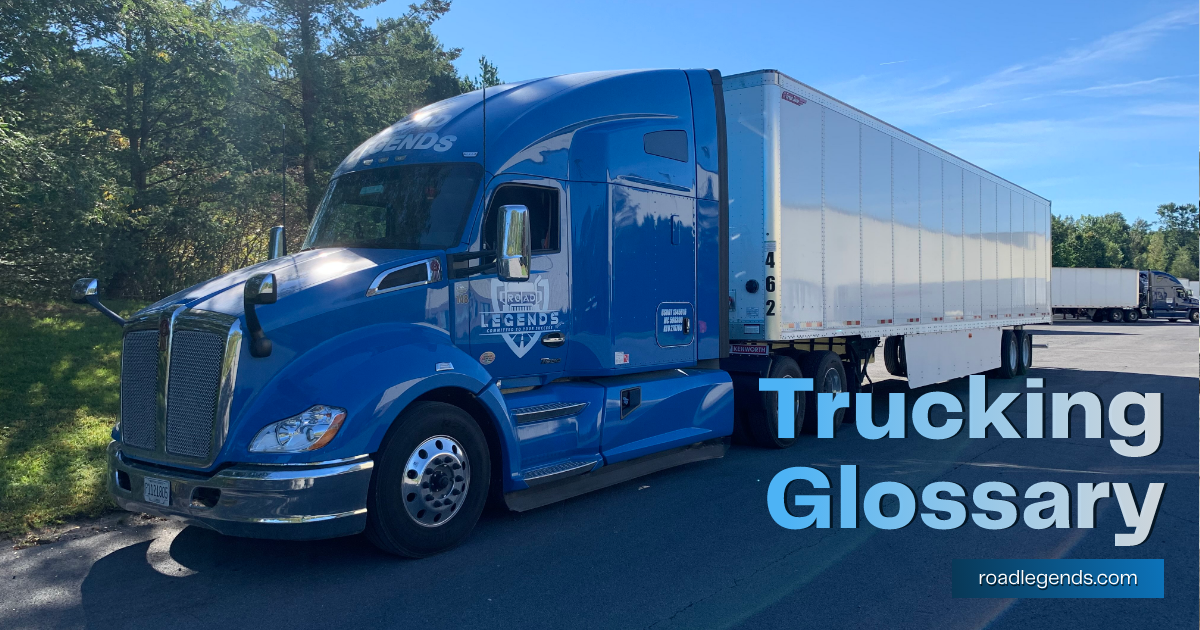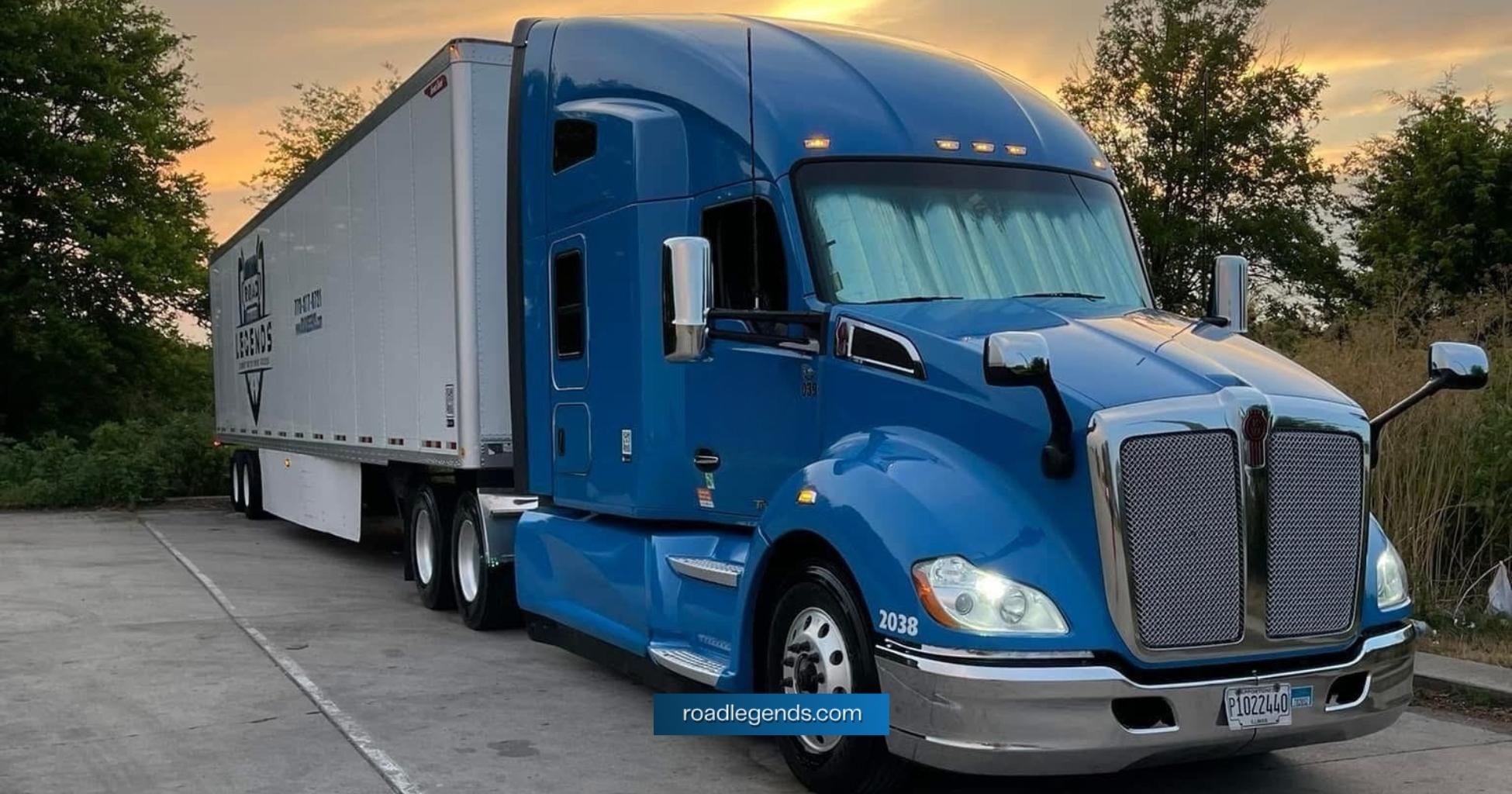
Trucking Terminology: Meanings and Definitions of Trucking Terms
Experienced truckers, whose rigs have logged more miles than most flights, are well-versed in trucking jargon. This might make entering or working in this industry from the outside seem daunting. The huge range of terms and phrases you'll hear can be puzzling, and just when you think you've mastered the trucking lingo, another term will appear. There are a bewildering number of phrases, acronyms, and federal regulatory agencies, used to describe every scrap of equipment utilized in the various areas of the industry.
In a nutshell, trucking lingo can be confusing.
We're hip enough to know the terminology here at Road Legends, and we're ready to teach you. To help you do so, we've compiled a list of the top trucking terminologies you'll need to know to properly navigate this sector.
This detailed guide will assist in the deciphering of some of the industry's more complicated lingo and processes. You'll be able to readily access this glossary at any time because it's all in one spot.
A
ABS: anti-lock brakes use brief applications of pressure to keep wheels from locking up during braking. In the snow, ice, or on wet roads, this frequently means shorter braking distances and safer operation.
Airfreight: cargo that is at least partially transported by air.
Authorized carrier: for a specific shipper, an authorized carrier is one who is on a list of pre-approved transportation carriers.
Axile: the steel shaft that connects the wheels on opposite sides of a vehicle.
Axle load: the official weight limit for trucks, as determined by the distribution of weight across each axle.
B
Backhaul: following delivery, the trip back to the point of origin.
Base plate: a semi tractor's license plate issued by the state where the vehicle is registered.
Bear: a state trooper or a highway patrol officer.
Bed bugge: a home goods driver or professional mover.
Bill of lading (BOL or B/L): a detailed list of the contents of a shipment.
Bobtail: a tractor-trailer with no trailer.
Broker: a professional who negotiates shipping arrangements and rates on behalf of an owner-operator or fleet.
Brake chamber: the operating portions of the brake are housed in a sealed canister. When the driver depresses the brake pedal, braking chambers on heavy-duty trucks convert air pressure to mechanical pressure, slowing the vehicle.
Brake drum: a brake drum is a revolving cylinder that creates friction when rubbed against by a brake pad or shoe, slowing the vehicle.
Bridge formula: a mathematical equation used by the Department of Transportation and state transportation authorities to estimate the maximum weight of commercial vehicles. Gross weight, number of axles, axle spacing, and overall length are all factors in bridge calculations.
Bulk carriers: they transport loose, unpackaged freight such as sand, gravel, petroleum, and scrap steel.
Bulk freight: coal, crude oil, crushed stone, and grain are examples of bulk freight that are shipped unpackaged in enormous quantities.
Bunk cab: a truck's sleeper berth, which normally contains a bed and storage places for the driver's clothes and personal belongings.
C
Cab card: a state-issued document that shows which states a commercial vehicle is permitted to operate in. The card contains information specific to the truck, is non-transferable, and the original must be kept in the cab at all times.
Cabover truck: a boxy, flat-front truck design in which the engine is located beneath the cab rather than under the hood in front, as it is on traditional tractors.
Camshaft: a spinning shaft with projecting lobes that open and close intake and exhaust valves while the engine is running.
Cargo: another name for freight or a commodity being transported.
Common carrier: a trucking company that transports freight to any destination. Other companies, on the other hand, solely haul to private or committed customers.
Contract carrier: a trucking company that transports freight to a limited number of customers under the terms of a trucking contract.
D
Deadhead: a backhaul with no freight. Deadheading makes little money and increases the cost per mile.
Dedicated run: a run that normally takes the same route and follows the same timetable every time. The majority of drivers 'want' a dedicated run. These runs are usually given to experienced/senior drivers.
Dispatcher: carrier employees that act as go-betweens for drivers and shippers. They're also a driver's main point of contact with the company, and they're responsible for a wide range of tasks.
Docks: sometimes known as loading docks are commonly seen at warehouses, manufacturing plants, and freight terminals.
Dock plates: massive steel plates that cover the gaps between trailers. Forklifts and other material handling equipment may easily enter and depart the truck or trailer thanks to dock plates.
Double bottom: a set of double trailers.
Dry box: an enclosed trailer that is used to transport common cargo that does not require climate control. Also known as dry vans.
Dump body: a cargo compartment on a truck or trailer chassis that is used to transport bulk materials such as sand, crushed stone, and topsoil. Dump bodies can be unloaded by floor gates or by elevating them and allowing the contents to spill out the back.
E
E-Log: A computer system that records a truck driver's mileage and service hours. Carriers will have immediate access to their driver's logs when employing an E-log. This enables carriers to better schedule their drivers.
ETA: estimated arrival time.
Excise taxes: taxes imposed on items such as tobacco, beer, gasoline, and diesel fuel.
Expediting: a type of transportation in which tiny, time-sensitive cargo is conveyed utilizing dedicated trucks that are usually driven by a team of drivers.
Extra-provincial operation: when trucks registered in one country are allowed to operate in another. This is frequently the case with trucking businesses that are licensed to transport freight into and out of both Canada and the United States.
F
Federal Excise Tax (FET): a set of levies imposed by the federal government to produce revenue.
Federal Motor Carrier Safety Regulations (FMCSR): a complete collection of motor carrier regulations available to drivers in a compact pocket-sized book that should always be carried with them.
Fifth Wheel: the huge, flat, and u-shaped connection device placed to the tractor's frame behind the cab is known as a fifth wheel. When the tractor is backed beneath a trailer, the kingpin moves into the fifth wheel and is held in place by steel jaws. Learn how to use the fifth wheel to slide.
A fiscal year: a 12-month period during which a trucking firm or owner-operator is required to report their financials. Fiscal years may begin at the start of a quarter and do not always correspond to the calendar year.
Freight: anything conveyed by a commercial vehicle, vessel, or airplane is referred to as freight. Clothing, food, and electronics are all examples of freight, as are lumber, coal, and petroleum goods.
Freight Bills: also known as freight invoices are final bills for transportation services sent by the carrier to the shipper. Freight bills differ from bills of lading in that they may incorporate services that were not initially included when the load was offered.
Freight forwarder: a person or company who coordinates shipments between shippers, carriers, and consignees. Because freight forwarders do not own their equipment, they must rely on carriers to transport their cargo.
G
Gear ratio: in mechanical terms, it is the number of spins an output shaft produces when the input shaft rotates once. When choosing a truck or tractor, the gear ratio is crucial since it impacts performance parameters such as low-end torque, cruising speed, and fuel consumption.
Glad hands: couplers that link service and emergency air lines from tractors to those on trailers. They interlock like two shaking hands when linked.
Glider kit: a new truck that has been marketed without an engine, transmission, driveline, or rear differential.
Grandfather clause: a provision that allows an old rule or regulation to continue to apply in particular instances despite the implementation of a new one.
GCWR: the maximum permissible total weight of a combination vehicle is referred to as the gross combined weight rating or gross combination weight rating. Vehicle and trailer manufacturers determine the GCWR.
GVW: the gross vehicle weight, or GVW, is a vehicle's maximum operational weight as established by the manufacturer. The chassis, cab, engine, fuel accessories, driver, and freight are all included.
H
Hazmat: hazardous materials are classified by the US Environmental Protection Agency and are regulated by the federal government.
Hours of service (HOS): federal laws governing the number of hours a truck driver may operate a commercial vehicle.
Header board: similar to a headache rack, except it is mounted to the front of a flatbed trailer rather than the truck or tractor's frame.
Heavy hauler: a truck designed to transport weights that are heavier than normal and require licenses and, in certain cases, escorts. Heavy haulers move goods that can't be easily broken down into smaller components, such as earth-moving equipment and transformers.
J
Just in Time (JIT): a manufacturer's utilization of small, frequent shipments of production parts to reduce on-site inventories.
L
Laden weight: the total weight of a vehicle, including its equipment, fuel, driver, and cargo.
Landing gear: the two massive retractable legs that hold a trailer while it is not attached to a tractor.
Lease: a contract in which the lessee pays the lessor for the use of an asset; in this context, it would mean lease purchase trucking.
Less-Than-Truckload (LTL): a tiny shipment, usually under 10,000 pounds, that is charged at a lower rate than a full truckload. On a single run, shippers frequently transport multiple LTL items to different destinations.
Logbook: a document that keeps track of driving hours, rest periods, and mileage in accordance with federal Hours of Service standards. Either a paper or an electronic logbook can be used.
Long-haul: a long-distance drive of several hundred miles or more.
P
Private carrier: a fleet that transports goods for its own company is known.
Proof of Delivery (POD): a signed document that documents the delivery of a load, usually the Bill of Lading.
Q
Qualcomm: carriers employ a wireless communication system that includes GPS, text messaging, and email. A Qualcomm enables the trucking company to track its drivers, as well as the status of deliveries and the weather.
O
Onboard computer: a computer that is mounted on vehicles such as trucks, trains, and airplanes and collects and stores data such as location, average speed, irregular maneuvers, and fuel consumption.
Operating authority: authority issued by the FMCSA to trucking businesses and owner-operators to transport commodities between states and across international borders. Motor Carrier (MC) and USDOT numbers are required for carriers with operating authorization.
Operational records: the documents relevant to all parts of the firm in which you're involved.
P
Piggyback: a flatbed trailer with its own forklift for loading and unloading on the back.
Pintle Hooks: big steel loops or hooks that connect a trailer to a power unit, or a trailer to a dolly.
Point of origin: the point where a shipment is picked up or a voyage begins.
Private carrier: a corporation that only transports its own products.
Proof of Delivery (POD): a piece of paper that certifies that a package has been delivered.
R
Relay: a run in which two drivers meet at a central place, exchange loads, and then return to their starting point.
Rider policy: it usually allows someone who is not employed by the company to accompany the driver in the vehicle. There may be restrictions based on age or season. Only immediate family members are sometimes specified.
Rigs: big trucks and tractor-trailer units in the transportation industry.
Rocky mountain doubles: tractor-trailer combinations that include a tractor, a 45 or 48-foot trailer, and a 28-foot pup trailer.
S
Semi-trailer: an unpowered freight compartment of a combination vehicle attached to a power unit or another trailer.
Setback axle: a steer axle that isn't fully forward against the front bumper on standard trucks and tractors. Trucks with setback axles can turn tighter than those with front steer axles.
Single-axle: the drive axle of a tractor. One axle drives a single-axle tractor, and one axle drives a single-axle trailer.
Spotter: a driver who shuttles trailers into and out of loading docks at a plant, terminal, or distribution facility, sometimes known as a yard jockey.
Spread axle: a trailer with many axles that are not parallel to one another like on ordinary trailers. Reefers and flatbeds are the most popular vehicles with spread axles.
Super trucker: a disparaging phrase for an inexperienced loudmouth who spends all of his time bragging about how much money he makes, how much experience he has, and what a lady's man he is in truck stop restaurants.
T
TL: abbreviation for a truckload. This is a fully loaded freight.
TL carrier: a trucking firm that transports a single truckload of freight.
Triple bottom: trailers discharge bulk commodities through three gates or funnels in the trailer's bottom. Commodities such as corn and grain are transported using triple bottoms.
Triple: a vehicle that consists of a tractor and three trailers.
Trip permit: permits a commercial vehicle operator to transport freight from one site to another without having to register the vehicle permanently. Operators can use trip permits to transport loads to and from locations where they don't normally operate.
Trolley brake: in the cab of a tractor, a brake lever that applies pressure to the trailer brakes when greater braking force is required than the service brakes can provide.
Tractor-trailer: a vehicle that combines a tractor and a trailer, or trailers.
W
Waybill: a document provided by a carrier that contains vital information and instructions about a specific shipment.
Weigh stations: government-run facilities that verify commercial vehicles' weights at random intervals, as well as perform mechanical and log inspections.
Wheelbase: computed by measuring the distance between the center of the steer axle's hub and the point between the two drive axle hubs on twin-screw or tandem drive tractors. The measurement is taken from the center of the steer axle's hub to the center of the drive axle's hub on a single axle tractor.
Final thoughts
You now know what each of these terms means and what part they play in this sector. Bookmark the page so you can return to it in the future.
A productive supply chain is one that is well-educated. Make use of this glossary in future purchasing decisions to get the most out of your shipping money.

Best 11 Trucking Podcasts We Bet You’ll Actually Enjoy
Country playlists and radio talk had their charm, but podcasts have completely changed the game for drivers. Check out this list of the 11 best trucking podcasts.

6 Practical Ways To Manage Truck Downtime Before It Costs You
Truck downtime can drain your revenue and hurt customer satisfaction. Discover simple, proactive steps to reduce downtime, improve fleet performance, and keep your trucks on the road where they belong.

Driver’s Knee Got You Down? Here’s How to Fight Back
Spending long hours on the road can lead to knee pain, known as Driver’s Knee. Learn how truckers can prevent and manage this common issue.